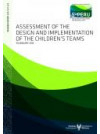In mid-2013 the Social Policy Evaluation and Research Unit (SuPERU) within the Families Commission commenced an assessment of the Children’s Team’s model. The Children’s Teams are a key component of the Government’s multi-year Children’s Action Plan (CAP). This report provides an assessment of the design and implementation of the Children’s Teams model.
Methodology
This assessment used a developmental evaluation approach drawing on multiple data sources. Developmental evaluation is used to understand the activities of programmes operating in dynamic and complex environments. Its emphasis is on providing a feedback loop that supports decision making and helping to formalise the learning that drive decisions.
Findings were derived through the analysis of data collected through observation, document review and semi-structured interviews with key personnel who were involved with service design and delivery. They were asked to discuss the current state of practice for the Children’s Teams, and to identify ways in which the Teams could be more effective. A two-day cross sector CAP workshop, including 140 non-government and government representatives, provided additional data and corroboration of salient themes. Evidence was also drawn from current literature that outlines factors that support successful integrated services, multi-disciplinary practice and capacity building (see appendix 2 for detail of data sources and interview guide).
A thematic analysis of the key issues with reference to the integrated services literature provided the framework for the findings. See Appendix 1 for a full description of the method.
Key Results
Our assessment found that the Children’s Teams had made positive progress on some elements such as building a shared vision, collective ownership and building a working model. However, other elements such as funding and accountability processes are currently posing challenges. Workforce capacity, common accountability measures and addressing services gaps are also likely to demand attention as the model progresses and expands.
The Children’s Teams have required an immense amount of energy to activate because change is required within existing agency/service and professional systems as well as between these systems. Multiple players were required to be on board, committed and clear about the purpose and scope and understand their role. This required integrated planning and investment with timeframes realistic to collaborative and complex initiatives of this scale.
The Children’s Teams were implemented before a design was agreed or uniformly understood and supported at every level. The demonstration sites have shouldered expectations that they will build an integrated service, test and pilot various components, and ‘demonstrate’ better results for vulnerable children. Expectations of what the demonstration sites would achieve were significant, and probably inappropriate, relative to the major design and development work still to be done.
The small scale of the Children’s Teams physical presence belies the progress made to date in getting the design right and implementing a working model that sets the Children’s Teams up for an expansion phase. The two demonstration sites established in Rotorua and Whangarei, succeeded in getting a workable system up and running and helped reveal the extent of what is needed for the model to be sustainable. There are currently signs of a more integrated planning approach, aligning service design with the governance, resourcing and timeframe requirements, to develop and implement the service successfully.

